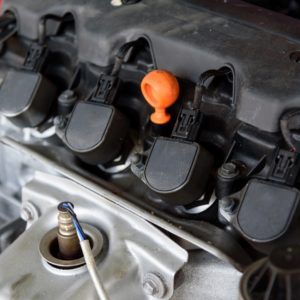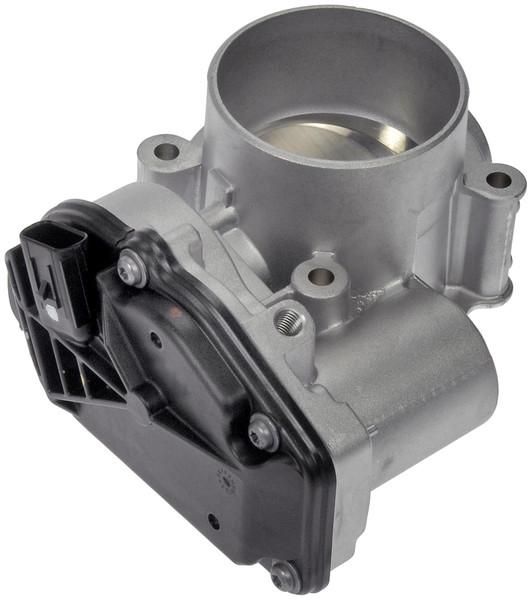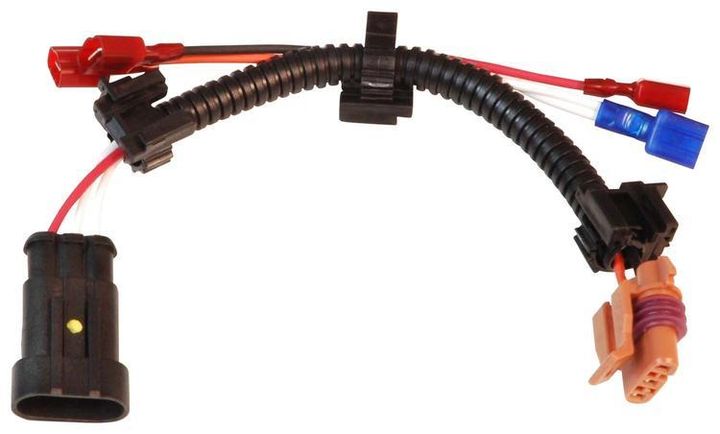


The On-Board Diagnostics II (OBD-II) system is a standardized system in vehicles that monitors and reports various issues related to the engine, transmission, and emissions control systems. When a fault is detected, the system generates a Diagnostic Trouble Code (DTC) to help identify the problem. One such code is P03FF, which specifically refers to a high voltage condition in the Ignition L Control Signal Circuit.

Before we dive into the nitty-gritty of the P03FF code, let's take a moment to appreciate the unsung hero of the ignition system – the ignition coil. This humble component plays a crucial role in transforming the low-voltage electrical energy from the battery into the high-voltage spark required to ignite the air-fuel mixture in the engine's cylinders.
| Component | Function |
|---|---|
| Ignition Coil | Transforms low battery voltage into high voltage for spark plugs |
| Primary Winding | Receives low voltage from the battery |
| Secondary Winding | Generates high voltage for the spark plugs |
| Laminated Iron Core | Concentrates and amplifies the magnetic field |
The ignition coil is a transformer that relies on electromagnetic induction to step up the voltage from the battery's 12 volts to the thousands of volts needed for the spark plugs. It's a delicate dance of electrical currents and magnetic fields, and when something goes awry, it can lead to a cascade of issues, including the dreaded P03FF code.
Now, let's delve into the heart of the matter – the P03FF code itself. This diagnostic trouble code indicates that the powertrain control module (PCM), the brain of your vehicle's engine management system, has detected an abnormally high voltage in the ignition coil control circuit.
This high voltage condition can be caused by a variety of factors, each with its own set of challenges and potential solutions. Buckle up, because we're about to embark on a diagnostic adventure!
One of the most common causes of the P03FF code is a faulty ignition coil. Over time, these components can develop internal short circuits or winding failures, leading to excessive voltage in the primary control circuit. It's like a short circuit in the coil's internal wiring, causing a voltage spike that the PCM perceives as an anomaly.
| Ignition Coil Failure Modes | Description |
|---|---|
| Internal Short Circuit | Insulation breakdown between windings or to the core |
| Winding Failure | Broken or shorted windings due to physical damage or overheating |
| Insulation Breakdown | Degradation of insulation material over time or due to excessive heat |
Another frequent offender is damaged wiring or connectors in the ignition coil control circuit. Wiring insulation can become chafed or corroded, leading to short circuits, while connectors can suffer from corrosion or physical damage, causing high resistance or short circuits in the control circuit.
| Wiring/Connector Issues | Description |
|---|---|
| Chafed Wiring | Insulation damage due to rubbing against other components |
| Corroded Connectors | Oxidation or contamination of connector terminals |
| Damaged Connectors | Bent or broken connector pins or housings |
In some cases, the ignition coil control circuit itself may become shorted to a power source, causing a high voltage condition that triggers the P03FF code. This can happen due to a variety of reasons, including wiring damage or a manufacturing defect.
While rare, it's also possible that the PCM itself may have an internal failure, causing it to send incorrect voltage signals to the ignition coil control circuit, resulting in the P03FF code.
As a mechanic, I follow a systematic approach to diagnose and resolve the P03FF code. Here are the steps I typically take:
Visual Inspection
Inspect the ignition coil, wiring, and connectors for any signs of damage or corrosion.
Look for chafed or burned wiring insulation, corroded or damaged connectors, and any physical damage to the ignition coil.
Battery Voltage Check
Verify that the ignition coil is receiving the proper battery voltage supply.
Check for voltage drops or fluctuations that could indicate a wiring or connection issue.
Circuit Testing
Use a digital multimeter to check for short circuits or excessive resistance in the ignition coil control circuit wiring.
Disconnect the ignition coil and measure the resistance of the control circuit wiring to identify any potential faults.
Ignition Coil Resistance Test
Perform a resistance test on the ignition coil itself to check for internal shorts or open circuits.
Compare the measured resistance values to the manufacturer's specifications for the specific ignition coil.
Technical Service Bulletins
Consult any relevant technical service bulletins (TSBs) for the specific vehicle make, model, and engine.
TSBs can provide valuable insights and known issues related to the P03FF code or ignition system components.
Scan Tool Diagnostics
Use a professional-grade scan tool to check for any other related trouble codes that may provide additional clues or context to the P03FF code.
Look for codes related to the ignition system, fuel system, or other engine management components that could be contributing factors.
Once the root cause of the P03FF code has been identified, it's time to roll up our sleeves and get to work. Here are the typical repair steps and preventive measures I recommend:
Ignition Coil Replacement
If the ignition coil fails the resistance test or shows signs of physical damage, it's time for a replacement.
Install a new, high-quality coil that meets or exceeds the manufacturer's specifications.
Wiring and Connector Repairs
If the issue lies with damaged wiring or connectors, carefully repair or replace the affected components.
This may involve splicing in new wiring sections, replacing entire harnesses, or replacing damaged connectors.
Short Circuit Repair
In cases where the control circuit is shorted to a power source, meticulously locate and repair the short circuit.
Inspect the entire wiring harness, connectors, and components for any signs of insulation damage or exposed conductors.
PCM Replacement
In the rare event that the PCM itself is the culprit, a replacement may be necessary.
However, exhaust all other diagnostic avenues before considering this option, as PCM replacements can be costly.
To help prevent future occurrences of the P03FF code and other ignition system issues, I recommend the following preventive measures:
Regular Maintenance and Inspections
Adhere to the manufacturer's recommended service intervals and perform regular inspections on the ignition system components.
This can help catch potential issues before they escalate and cause more significant problems.
Proper Wiring Routing and Protection
Ensure that wiring harnesses are properly routed and protected from potential chafing or damage.
Use appropriate wire loom, grommets, and cable ties to secure and protect the wiring.
Dielectric Grease on Connectors
Apply a thin layer of dielectric grease on electrical connectors to help prevent corrosion and ensure a secure connection.
This can reduce the risk of high resistance or short circuits in the control circuit.
Following Service Intervals
Strictly follow the manufacturer's recommended service intervals for ignition system components, such as spark plugs and ignition coils.
Replacing these components at the recommended intervals can help prevent premature failures and associated issues.
Proper Maintenance Procedures
Follow the manufacturer's recommended maintenance procedures and torque specifications when working on the ignition system.
Improper installation or handling of components can lead to premature failures or damage.
The cost of repairs related to the P03FF code can vary significantly depending on the specific cause and the vehicle make and model. Here's a general breakdown of potential costs:
| Repair | Typical Cost Range |
|---|---|
| Ignition Coil Replacement | $100 - $300 (including parts and labor) |
| Wiring Repairs | $200 - $500 (depending on the extent of the work) |
| Connector Replacement | $50 - $200 (depending on the number of connectors) |
| PCM Replacement | $500 - $1,500 (including programming and labor) |
It's important to note that these cost ranges are approximate and can vary based on factors such as the vehicle make and model, labor rates in your area, and any additional diagnostic or repair work required.
It's always advisable to consult with a professional mechanic and obtain a detailed quote after a proper diagnosis has been performed. This way, you can make an informed decision and budget accordingly for the necessary repairs.
Dealing with the P03FF – Ignition L Control Signal Circuit High code can be a challenging endeavor, but with the right knowledge and diagnostic approach, it's a puzzle that can be solved. As a mechanic, I've learned that patience, attention to detail, and a systematic approach are key to unraveling these types of issues.
Remember, preventive maintenance and regular inspections can go a long way in avoiding costly repairs and ensuring the longevity of your vehicle's ignition system. By following the recommended service intervals, using proper maintenance procedures, and addressing any issues promptly, you can help keep your ride running smoothly and avoid the dreaded P03FF code.
Happy motoring, and may your ignition coils always fire on all cylinders!
The ignition coil transforms the low battery voltage into the high voltage required to create a spark across the spark plugs, igniting the air-fuel mixture in the engine cylinders.
An ignition coil with an internal short circuit or winding failure can cause excessive voltage in the primary control circuit, triggering the P03FF code.
A shorted control circuit can lead to misfiring, poor engine performance, and potential damage to the ignition system components or the PCM if left unresolved.
Yes, chafed or corroded wiring insulation in the ignition coil control circuit can create short circuits, leading to the P03FF code being set by the PCM.
Corroded or damaged connectors in the ignition coil control circuit can cause high resistance or short circuits, resulting in abnormal voltage levels detected by the PCM.
A resistance test on the ignition coil helps identify internal shorts or open circuits, which can be a potential cause of the P03FF code.
Technical service bulletins may provide valuable information on known issues, updates, or specific diagnostic procedures related to the P03FF code or ignition system components for a particular vehicle make and model.
Proper safety measures, such as disconnecting the battery and using insulated tools, should be followed when working on the ignition system to avoid potential electrical shocks or short circuits.
In rare cases, if no other issues are found, a PCM replacement may be necessary to resolve the P03FF code, but this should be considered as a last resort after exhausting all other diagnostic avenues.
Regular maintenance, proper wiring routing and protection, using dielectric grease on connectors, following service intervals, and adhering to recommended maintenance procedures can help prevent future occurrences of the P03FF code.

Miguel started tinkering with car radios as a teenager, fascinated by the intricate dance of wires and circuits. This passion led him to pursue a career as an automotive electrician. For the past 10 years, Miguel has tackled everything from flickering headlights to mysterious electrical gremlins. He thrives on troubleshooting electrical problems and enjoys sharing his knowledge to empower car owners to understand their vehicles better.



